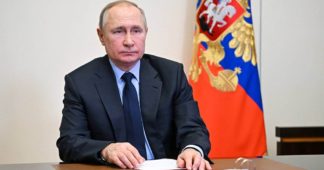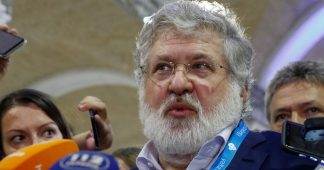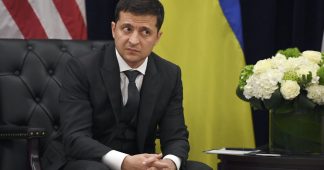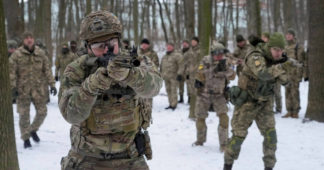The Threatened Peoples of East Asia and Europe Can Stop the U.S. Drive to Restore its Global Domination
Posted on
“This is not going to be a war of Ukraine and Russia. This is going to be a European war, a full-fledged war.” So spoke Ukraine’s President Volodymyr Zelensky just days after berating the US for beating the drums of war.
It is not hard to imagine how Zelensky’s words must have fallen on those European ears that were attentive. His warning surely conjured up images of World War II when tens of millions of Europeans and Russians perished.
Zelensky’s words echoed those of Philippine’s President Rodrigo Duterte on the other side of the world at the Eastern edge of the great Eurasian land mass: “When elephants fight, it is the grass that gets trampled flat.” We can be sure that Duterte, like Zelensky, had in mind WWII which also consumed tens of millions of lives in East Asia.
The United States is stoking tensions in both Europe and East Asia, with Ukraine and Taiwan as the current flashpoints on the doorsteps of Russia and China which are the targeted nations. Let us be clear at the outset. As we shall see, the endpoint of this process is not for the US to do battle with Russia or China but to watch China and Russia fight it out with the neighbors to the ruin of both sides. The US is to “lead from behind” – as safely and remotely as can be arranged.
To make sense of this and react properly, we must be very clear-eyed about the goal of the US Neither Russia nor China has attacked or even threatened the US Nor are they in a position to do so – unless one believes that either is ready to embark on a suicidal nuclear war.
Why should the US Elite and its media pour out a steady stream of anti-China and anti-Russia invective? Why the steady eastward march of NATO since the end of the first Cold War? The goal of the US is crystal clear – it regards itself as the Exceptional Nation and entitled to be the number one power on the planet, eclipsing all others.
This goal is most explicitly stated in the well-known Wolfowitz Doctrine drawn shortly after the end of the first Cold War in 1992. It proclaimed that the US’s “first objective is to prevent the re-emergence of a new rival, either on the territory of the former Soviet union or elsewhere….” It stated that no regional power must be allowed to emerge with the power and resources “sufficient to generate global power.” It stated frankly “we must maintain the mechanism for deterring potential competitors from even aspiring to a larger regional or global power.” (Emphasis, jw)
The Wolfowitz Doctrine is but the latest in a series of such proclamations that have proclaimed global domination as the goal of US foreign policy since 1941 the year before the US entered WWII. This lineage is documented clearly in the book by the Quincy Institute’s Stephen Wertheim “Tomorrow, The World: The Birth of US Global Supremacy.”
Let us consider China first and then Russia, the foremost target of the U.S., first. China’s economy is number one in terms of PPP-GDP according to the IMF and has been since November, 2014. It is growing faster than the US economy and shows no signs of slowing down. In a sense China has already won by this metric since economic power is the ultimate basis of all power.
But what about a military defeat of China? Can the US with its present vastly superior armed forces bring that about? The historian, Alfred McCoy, answers that question in the way most do these days, with a clear “no”:
“The most volatile flashpoint In Beijing’s grand strategy for breaking Washington’s geopolitical grip over Eurasia lies in the contested waters between China’s coast and the Pacific littoral, which the Chinese call “the first island chain.”
“But China’s clear advantage in any struggle over that first Pacific island chain is simply distance. …The tyranny of distance, in other words, means that the US loss of that first island chain, along with its axial anchor on Eurasia’s Pacific littoral, should only be a matter of time.”
Certainly the US Elite recognizes this problem. Do they have a solution?
Moreover, that is not the end of the “problem” for the US There are other powerful countries, like Japan, or rapidly rising economies in East Asia, easily the most dynamic economic region in the world. These too will become peer competitors, and in the case of Japan, it already has been a competitor both before WWII and during the 1980s.
If we hop over to the Western edge of Eurasia, we see that the US has a similar “problem” when it comes to Russia. Here too the US cannot defeat Russia in a conventional conflict nor have US sanctions been able to bring it down. How can the US surmount this obstacle? And as in the case of East Asia the US faces another economic competitor, Germany, or more accurately, the EU, with Germany at its core. How is the US to deal with this dual threat?
One clue comes in the response of Joe Biden to both the tension over Taiwan and that over Ukraine. Biden has said repeatedly that he will not send US combat troops to fight Russia over Ukraine or to fight China over Taiwan. But it will send materiel and weapons and also “advisors.” And here too the US has other peer competitors most notably Germany which has been the target of US tariffs. The economist Michael Hudson puts it succinctly in a penetrating essay, “America’s real adversaries are its European and other allies: The US aim is to keep them from trading with China and Russia.”
Such “difficulties for the US were solved once before – in WWII. One way of looking at WWII is that it was a combination of two great regional wars, one in East Asia and one in Europe. In Europe the US was minimally involved as Russia, the core of the USSR, battled it out with Germany, sustaining great damage to life and economy. Both Germany and Russia were economic basket cases when the war was over, two countries lying in ruins.
The US provided weapons and materiel to Russia but was minimally involved militarily, only entering late in the game. The same happened in East Asia with Japan in the role of Germany and China in the role of Russia. Both Japan and China were devastated in the same way as were Russia and Europe. This was not an unconscious strategy on the part of the United States. As Harry Truman, then a Senator, declared in 1941: “If we see that Germany is winning the war, we ought to help Russia; and if that Russia is winning, we ought to help Germany, and in that way let them kill as many as possible.. . ”
At the end of it all the US emerged as the most powerful economic and military power on the planet. McCoy spells it out:
“Like all past imperial hegemons, US global power has similarly rested on geopolitical dominance over Eurasia, now home to 70% of the world’s population and productivity. After the Axis alliance of Germany, Italy, and Japan failed to conquer that vast land mass, the Allied victory in World War II allowed Washington, as historian John Darwin put it, to build its “colossal imperium… on an unprecedented scale,” becoming the first power in history to control the strategic axial points “at both ends of Eurasia.”
“As a critical first step, the US formed the NATO alliance in 1949, establishing major military installations in Germany and naval bases in Italy to ensure control of the western side of Eurasia. After its defeat of Japan, as the new overlord of the world’s largest ocean, the Pacific, Washington dictated the terms of four key mutual-defense pacts in the region with Japan, South Korea, the Philippines, and Australia and so acquired a vast range of military bases along the Pacific littoral that would secure the eastern end of Eurasia. To tie the two axial ends of that vast land mass into a strategic perimeter, Washington ringed the continent’s southern rim with successive chains of steel, including three navy fleets, hundreds of combat aircraft, and most recently, a string of 60 drone bases stretching from Sicily to the Pacific island of Guam.”
The US was able to become the dominant power on the planet because all peer competitors were left in ruins by the two great regional wars in Europe and East Asia, wars which are grouped under the heading of WWII.
If Europe is plunged into a war of Russia against the EU powers with the US”leading from behind,” with material and weapons, who will benefit? And if East Asia is plunged into a war of China against Japan and and whatever allies it can drum up, with the US”leading from behind,” who will benefit?
It is pretty clear that such a replay of WWII will benefit the US In WWII while Eurasia suffered tens of millions of deaths, the US suffered about 400,000 – a terrible toll certainly but nothing like that seen in Eurasia. And with the economies and territories of Eurasia, East and West, in ruins, the US will emerge on top, in the catbird seat, and able to dictate terms to the world. WWII redux.
But what about the danger of nuclear war growing out of such conflicts? The US has a history of nuclear “brinksmanship,” going back to the earliest post-WWII days. It is a country that has shown itself willing to risk nuclear holocaust.
Are there US policy makers criminal enough to see this policy of provocation through to the end? I will leave that to the reader to answer.
The Peoples of East and West Eurasia are the ones who will suffer most in this scenario. And they are the ones who can stop the madness by living peacefully with Russia and China rather than serving as cannon fodder for the US There are clear signs of dissent from the European “allies” of the US, especially Germany but the influence of the US remains powerful. Germany and many other countries are after all occupied by tens of thousands of US troops, their media heavily influenced by the US and with the organization that commands European troops, NATO, under US command. Which way will it go?
In East Asia the situation is the same. Japan is the key but the hatred of China among the Elite is intense. Will the Japanese people and the other peoples of East Asia be able to put the brakes on the drive to war?
Some say that a two-front conflict like this is US overreach. But certainly, if war is raging on or near the territories of both Russia and China, there is little likelihood that one can aid the other.
Given the power of modern weaponry, this impending world war will be much more damaging than WWII by far. The criminality that is on the way to unleashing it is almost beyond comprehension.
J* ohn V. Walsh, until recently a professor of physiology and neuroscience at the University of Massachusetts Chan Medical School, has written on issues of peace and health care for Asia Times, San Francisco Chronicle, EastBayTimes/San Jose Mercury News, LA Progressive, Antiwar.com, CounterPunch and others.
Published at original.antiwar.com
We remind our readers that publication of articles on our site does not mean that we agree with what is written. Our policy is to publish anything which we consider of interest, so as to assist our readers in forming their opinions. Sometimes we even publish articles with which we totally disagree, since we believe it is important for our readers to be informed on as wide a spectrum of views as possible.











